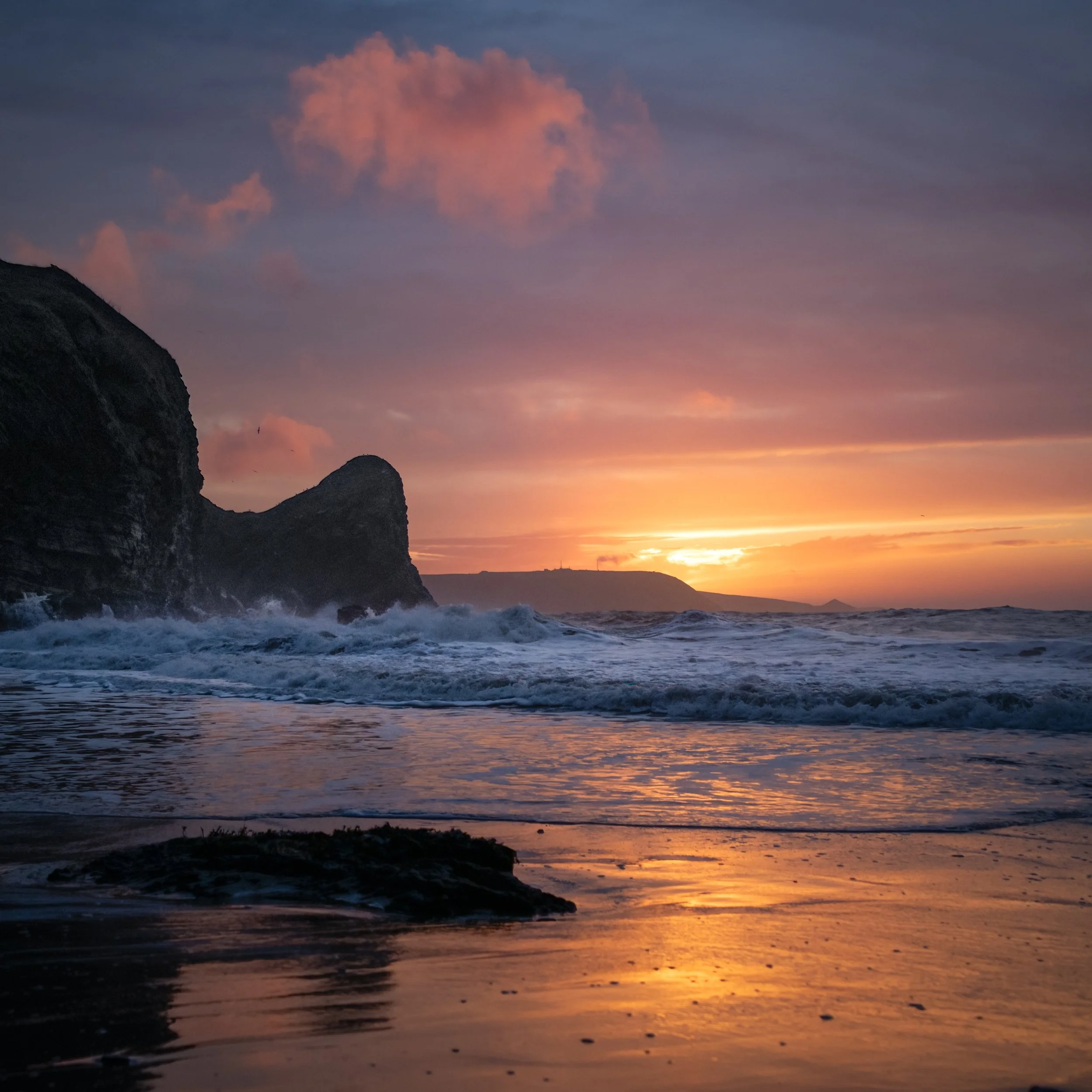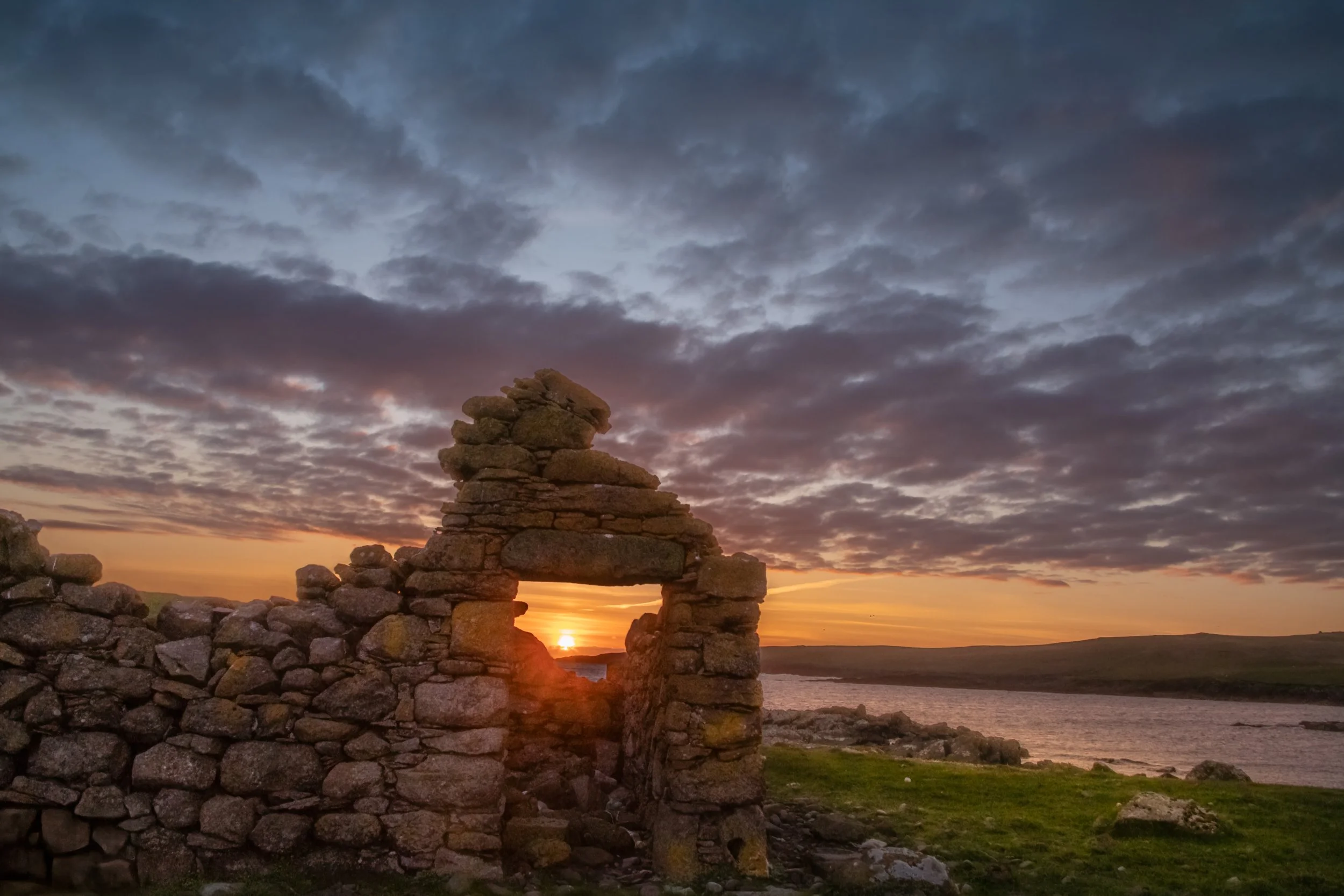THE SKY
“Excuse me while I kiss the sky”
An Teallach is a part of the “Great Wilderness” which stretches from the northern shore of Loch Maree up as far as Dundonnell and is one of the wildest places in the UK that is completely uninhabited and without any roads. The road in the image is on the northern edge of the wilderness. I was stopping off for the night in a parking area on this exposed plateau, as I was happy at the thought of waking up to a view of this mighty mountain, when the sky lit up with one of the most dramatic sunsets I’d ever seen. With recent snow still on the mountain, emphasising its contours, I couldn’t have been happier with what I was witnessing. A panorama which included the whole mountain was definitely the order of the day. In the edit I wanted to keep the foreground dark, but to have just enough light on it to sense its rolling outlines and see the fragment of road.
Auroras seen at Ceibwr in north Pembrokeshire in 2024. Many auroras, looking spectacular in camera, but with the naked eye are somewhat underwhelming. Using a long exposure of around 30 seconds will pick up the lights in a way that the eye simply cannot. But on this occasion the aurora was so strong that it was visible in all its glory. I had mentioned that this was possible in a phone call with a friend earlier in the evening: “I feel a bit tired and not sure if I’ll go though” I said. “Don’t be ridiculous, that’s so lazy. Just get your stuff together and get out there”. So I did, and eternally grateful for the shove! Ceibwr has so many photographic possibilities, and the aurora was everywhere over the sea and coastline, so I was spoiled for choice. I’ve chosen this classic view, and hoppy that I’ve picked up the full range of colours as well as the stars. Because I was using a long exposure, the stars are very slightly streaked: I didn’t have my star tracker with me which would have corrected that, but I think that is a fairly minor issue when the spectacle is this spectacular! Here is Wales we are lucky to be able to view an aurora like this - that is only possible because we are at the extreme point of the 11-year solar cycle.
A storm over the Torridon range, with Loch Torridon in front. One minute the mountains were clear, the next totally obscured. I waited until the rainclouds veiled the peaks partially so that their outline was still visible. The patch of sunlight on the slopes in the middle was a bonus. This was a three-image panorama, with the sky the primary focus. The foreground trees with their contrasting colour, and the gap in the middle of them leading the eye onto the central mountain and sky, contributes to what makes this a memorable image. And with Scottish weather, we have to be ready to react very quickly to an opportunity!
Cwm yr Eglwys, north Pembrokeshire sunrise. This was a highly planned photo. First, I’d noticed one evening from my weather apps that the sunrise might be a special one the next day; then I’d looked at my Photo Pills app to see if anywhere on the West Wales coast would be good for a sunrise, as generally West-facing coasts are more suited to sunsets than sunrises. I noticed that Cwm yr Eglwys fitted exactly, as the coast opposite faced in an Easterly direction. I also saw from the app that the sun would rise exactly between the church and the headland. That clinched it. I’d been about to go to bed, but instead got everything ready, making sure I had some coffee and cafetiere in my van, as well as a bit of breakfast, and headed off. I arrived 40 minutes later and set my alarm for very early o’clock, and a few hours later was drinking a quick coffee and then out with the camera and tripod to get everything ready for when the sun began to appear above the horizon. Miraculously everything went like clockwork. The gleaming path in the front works well as a compositional element, as does the bench, and a bonus was the tree on the right. The sky was one of the most spectacular I’d seen at sunrise.
Suilven, from Glen Canisp, just after sunrise. I felt I was in the right place for this sunrise, with the sunlight coming in from the left. There was a subtle orange glow which showed more obviously in its reflection in the water. But I particularly liked the tinted light falling obliquely onto the rocky ground underneath the mountain. Unfortunately that light didn’t quite reach the tops of the Scots pines in the right foreground, which would have been a bonus.
A lovely sunset at Llangrannog beach in Ceredigion. I kept low to maximise the golden reflections in the sand and water, and timed the photo to include a breaking wave. Aberporth and the tell-tale shape of Mwnt are seen in the background, and the imposing profile of the cliff and rock on the left are as much a feature of Llangrannog as the more well-known Carreg Bica which on this occasion is behind the camera…
Capel y Mwnt, or Mwnt chapel with the Milky Way. I needed two four-minute exposures to get the final image: the first one was for the sky, and used my Nomad star tracker, which kept the camera tracking the stars which relative to the earth move very slowly across the sky with the pole star as the axis of rotation; this ensures that the stars do not look streaky in the final image. The second exposure is for the chapel and ground, where the star tracker is not used. Those two images are seamlessly blended in the edit. In more complex astrophotography, many more than two images are required. The star tracker is a little box that is placed between the tripod and the camera, and must be aligned to the pole star by means of its inbuilt laser. It is an unforgettable experience to be out by the coast under the stars - calm, peaceful and therapeutic.
A headland near Eshaness in Shetland. I was wandering around and feeling increasingly manic in my efforts to find the perfect location for what was promising to be a beautiful sunset. I’d almost given up when I came across this dilapidated croft. I set up so that I would be ready to press the shutter just as the sun was beginning to disappear beneath the horizon, and in the middle of the old doorway. I did a three-image exposure bracket to ensure that there would be enough detail retained in both the dark and light areas. I wanted the little “ribbon” of sea both to give context and also as a line to lead the eye from the edge of the photo to the sun framed within the doorway as focal point of the image.
I think all photographers have been in a situation where they realize that they are in the wrong place to capitalize on some dramatic light which suddenly appears. On this occasion I had been in the hills of Mid-Wales during the day, and stayed in one particular valley hoping for a sunset image to cap a good day’s work. As time went on, I realized that this was not going to happen in this location; however I could see all kinds of things beginning to kick off in the sky a long way West, on the Cardigan Bay coast. I moved quickly, but thought it unlikely I would get there on time, as it was a considerable drive. Fortunately, I arrived just in time at the seaside town of Aberaeron. The sun was setting with a glorious textured orange behind the masts of yachts in the harbour. I took the photo, and two minutes later the light had gone. On this occasion then: a result! However, to keep sane as a photographer you also need to be happy on the many occasions that luck does not come your way. Just enjoy being out in nature and keeping alert.
Taken many years ago, I still like this image! There was some unsettled weather as I arrived at Kylesku bridge in the far North of Scotland. Heavy showers were alternating with sunshine, and I thought there might be an image, especially as the bridge is set amongst hills and mountains. I walked up a hill nearby and in the slight haze saw layer upon layer of hills, visually separated by the varying levels of haze. What’s more I was above a solid layer of cloud on the right, with a single hill penetrating above it, and on the left a rain cloud and sun beams penetrating down, like a finger pointing. This was a study in greys and a counterpoint of lines and demanded to be a black and white image.
Poppit Sands and the river Teifi emerging into Cardigan Bay. Another sunset image. The colours of the sunset were revealed in the ripples on the river and in the water at the beach. I created a panorama which showed the whole sweep of the bay. Another occasion when you need to drop everything and make use of the moment. I had looked at the weather map which showed unadulterated solid grey for almost the whole of Wales, but with one very small gap, appearing just before sunset and at this exact place. I was sceptical of that degree of accuracy in a forecast, but it was worth a try! On this occasion I got lucky. The view from Gwbert across to Poppit is well-known in the area, and there’s even a car park simply for the purpose of looking at the view, although I needed to walk across a couple of fields and through some nettles and brambles to reach the best spot for this panoramic image.
All the photographic guides list Neist Point and its lighthouse as a highlight of the Isle of Skye; they also pinpoint a certain recommended point for taking a photo. But in my usual way, I was after something different. I wasn’t sure what, but took a dirt road along the coast, sharing it with only one or two other intrepid explorers. Near where I had decided to park the van overnight I found this view where the sun would set behind the headland. I am really pleased with this image; the silhouette of the lighthouse is visible towards the end of Neist Point.
Early morning mist lying in and around the Teifi Valley in West Wales. The countryside always looks at its best in the these conditions, which occur quite regularly. The contours and layers are emphasised, and often the high points look like islands in a sea of mist.
Storm on Cadair Idris. I loved the look of the high ground dusted with snow; the path is emphasised too, and the walker gives scale to the photo. The sky is something that you can keep looking at without tiring of it. The beauty and bleakness high up the mountain is addictive.













